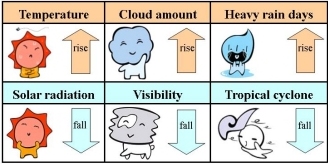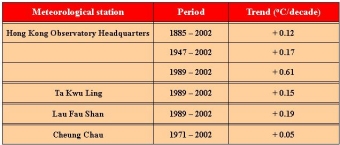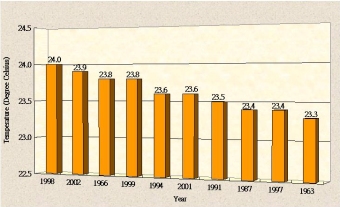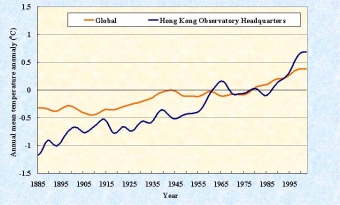Press Release
Global warming - the Hong Kong connection (1 August 2003)
Research conducted by the Hong Kong Observatory indicates that Hong Kong has been warming up during the past 118 years, in line with the global warming trend. In the last ten years or so, the rural areas of Hong Kong have been warming up at a rate of about 0.2°C per decade. At the Observatory Headquarters in the heart of urban Hong Kong, the corresponding rise was about 0.6°C per decade. The difference of 0.4°C per decade between temperatures in urban and rural areas can be attributed to the effects of urbanization.
Recently, global warming and the associated climate change have become the focus of scientific research. In 1988, the Intergovernmental Panel on Climate Change (IPCC) was established, with its secretariat run by the World Meteorological Organization (WMO). The main function of IPCC is to provide governments and the international community with authoritative scientific assessments on climate change, its potential impact and the possible response strategies. According to the latest assessment report by IPCC, the global average surface temperature has increased by approximately 0.6°C in the 20th century due to increase in the concentration of greenhouse gases in the atmosphere. At the Hong Kong Observatory Headquarters in Tsimshatsui, temperature readings have been accumulated for the 118 years period from 1885 to 2002, apart from a break during the wartime from 1940 to 1946. Analysis of the temperature data indicates that there was an average rise of 1.2°C per 100 years. The annual mean temperature rose from 22.0°C in the late 19th century to a mean of 23.5°C in the most recent decade. The warming has become significantly faster in the last ten years or so (1989 - 2002), reaching 6°C per 100 years.
As global warming and the associated changes in the global climate system will have significant impacts on eco-systems, human health, social and economic activities, etc., the issue of climate change has caused great concern among governments and the public. In view of this, the Hong Kong Observatory makes use of data collected through the decades to study the climate change in Hong Kong.
Mr. YEUNG Kai-hing, Assistant Director of the Hong Kong Observatory, said, "According to the assessment of IPCC, there is a global warming trend. For the Northern Hemisphere, the 1990s was the warmest decade since instrumental records began in 1861, and 1998 was believed to be the warmest year during the past millennium. Something similar occurred in Hong Kong. The 1990s was the warmest decade since records at the Observatory began in 1885. 1998 was the warmest year with a mean temperature of 24.0°C. Among the seven hottest years, six occurred after 1990."
There are considerable differences between the changes in the daily minimum temperature and the daily maximum temperature at the Hong Kong Observatory Headquarters. In the 56-year period after World War II, the mean daily minimum temperature shows a rising trend of 0.28°C per decade. In the same period, the number of cold days in a year (with temperatures of 12.0°C or lower at the Hong Kong Observatory Headquarters) has been decreasing at about 3 days per decade. In the 1950s, the number of cold days averaged about 28 days per year. In the most recent ten years (1993 to 2002), it averaged only about 13 days annually, a drop of more than 50% in half a century. On the other hand, there has been very little change in the daily maximum temperature. The frequency of occurrence of very hot days (33.0°C or above at the Hong Kong Observatory Headquarters) has remained largely unchanged at about 11 days per year.
At the Ta Kwu Ling station in the northern New Territories and the Lau Fau Shan station on the northwestern coast of the New Territories, the mean temperatures rose by 0.15 and 0.19°C per decade respectively since 1989. At the station situated on the island of Cheung Chau, no significant change in the annual mean temperature has been observed since 1971. The rate of annual temperature rise there is only about 0.05°C per decade. The difference in temperature trends among these stations and the station at the Hong Kong Observatory Headquarters can be attributed to differences in the effects of global warming, urbanization and modulation effects of the ocean.
Mr. YEUNG Kai-hing further explained the effect of urbanization on temperature at a particular location. He said, "Buildings and other concrete surfaces in urban areas retain the heat produced by solar radiation during the day and release the heat during the night. This results in a slower fall of temperature during the night and a higher minimum temperature than when buildings were absent."
Urbanization also results in reduction in visibility, increase in cloud amount and decrease in global solar radiation in Hong Kong.
Urbanization often causes an increase in suspended particulates in the atmosphere and thus a decrease in visibility. As a result, the amount of solar radiation reaching the ground decreases. The rise in temperatures during daytime was reduced but this is more or less offset by the heat generated from air conditioning and other urban activities. The net result is little change in the daily maximum temperature. Overall, the annual mean temperature rises but at a slower rate than the annual mean minimum temperature. Mr Yeung remarked, "Although we are not getting more hot days, cold nights are becoming less frequent".
To evaluate the potential impact of global warming, one can compare the temperature trend at the Hong Kong Observatory Headquarters with the global trend. It can be observed that the temperature at the Observatory Headquarters followed more or less the same trend as the global temperature during the pre-World War II period. In the post-war years, there were two periods with notable temperature rises at the Hong Kong Observatory Headquarters. The first was from mid-1950s to mid-1960s. The second period of rise begins in the 1980s, and ties in with the global trend of significant warming in the past two decades.
A faster rate of warming at the Hong Kong Observatory Headquarter compared to the global trend since the 1980's can be attributed to the effects of high density urban development. At Cheung Chau, no significant temperature rise is found since the 1970s, indicating that changes in temperatures over the seas around Hong Kong is small. During the last 10 years or so, the annual mean temperatures at Lau Fau Shan and Ta Kwu Ling, both located in the rural parts of Hong Kong, rose by about 0.19°C and 0.15°C respectively, slightly less than the global rate of 0.21°C for the same period. These two stations can be seen as representing regions in Hong Kong that are less affected by urbanization. In contrast, at the heart of urban Kowloon, the Observatory Headquarters recorded an additional rise of 0.4°C per decade due to urbanization.
From meteorological observations made at the Hong Kong Observatory Headquarters, the visibility in Hong Kong has a deteriorating trend. The number of hours in a year with reduced visibility due to suspended particulates (visibility below 8 km but excluding cases due to rain, mist or fog) has been increasing. In the early 1970s, Hong Kong experienced reduced visibility of 8 km or less for about 2% of the time. By 2002, it has increased to some 9%, around 4 times that of the early 1970s.
The cloud amount in Hong Kong has increased during the past 40 years from below 65% in the 1960s to around 70% in the recent decade. One possible cause is the increase in suspended particulates in the air due to urbanization resulting in increased condensation nuclei which favour the formation of clouds.
Both the increase in the concentration of suspended particulates and the increase in cloud amount would reduce the amount of solar radiation reaching the surface. At the King's Park station, the observed global solar radiation decreased from the mid-1960s to the mid-1980s, and at a slower rate subsequently. For the whole 40-year period, the annually averaged daily global solar radiation has decreased by about 26%, at a rate of 1 MJm-2 (the mean value between 1964 and 2002 being 13.7 MJm-2). Accompanying the decrease in global solar radiation, the annual total evaporation recorded at King's Park also decreased significantly by 40% from the 1960s to the present (the mean value between 1964 and 2002 being 1405 mm). Mr Yeung remarked, "It probably takes longer nowadays to dry our laundry in open air because of decreasing solar radiation and total evaporation."
According to records at the Hong Kong Observatory Headquarters, the frequency of occurrence of heavy rain has increased slightly after World War II. The annual number of days with heavy rain has increased at a rate of about 0.4 per decade, from about 5 days in the 1950s to about 6 days in the 1990s. Here heavy rain means rainfall exceeding 30 mm in an hour, the criterion for Amber Rainstorm Warning. This increase is far less than the year-to-year fluctuation of the number of heavy rain days (ranging from 1 to 13 days per year). Annual rainfall has also increased from 2265 mm in the 1950's to 2518 mm in the 1990's, by about 11%.
According to the observations in the past 40 years, the annual number of tropical cyclones landing over the south China coast within 300 km of Hong Kong has been decreasing at a rate of about 0.17 per decade, from about 3 tropical cyclones in the 1960s to about 2.5 tropical cyclones in the 1990s.
Mr. YEUNG Kai-hing, Assistant Director of the Hong Kong Observatory, further added, "The Hong Kong Observatory attaches great importance to climate change. Climate change is not only a scientific issue, it is also closely related to the environment, energy use and economic activities. Various computer climate models forecast a continuing rise in the global average temperature, of 1.4 to 5.8°C from 1990 to 2100. This would result in further changes in the global climate system. The Observatory will strengthen its research on climate change and promote public understanding of this subject. The Observatory will also actively cooperate with other government departments and WMO in the field of climate change, contributing towards the greater goal of sustainable development."
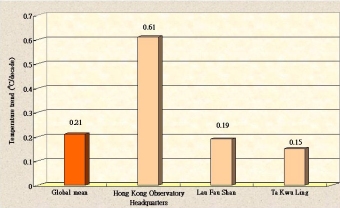
The warming trend globally and for Hong Kong in the last ten years or so
Trends of Hong Kong's meteorological parameter
Ten highest annual mean temperature recorded at the Hong Kong Observatory Headquarters
Temperature anomaly globally and at the Hong Kong Observatory Headquarters
